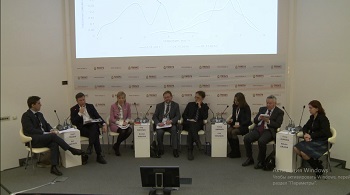Pavel Trunin: A Decrease in the Rate of Inflation is the Result of the Russian Central Bank’s Successful Policy
Within the framework of the 9th Gaidar Forum, Pavel Trunin, Head of the Center for Macroeconomics and Finance held the discussion: “Challenges to the Russian Central Bank’s Monetary Policy amid the Inflation Rate Slowdown”.

In 2017, the Central Bank of Russia kept carrying out a moderate monetary policy aimed at achieving the target inflation rate level of 4%. It is to be noted that H2 2017 witnessed a considerable deviation of the actual inflation rate from the target level. So, it was relevant to discusses the sources and consequences of the difference between the target and actual rates of inflation and analyze the impacts it might have on the economic dynamics and inflationary expectations of economic agents.
Participants in the discussion were as follows: Igor Dmitriev, Director of the Monetary Policy Department, Central Bank of the Russian Federation; Oleg Solntsev, Head of the Center for Monetary Policy and Banking Sector Analysis, Center for Macroeconomic Analysis and Short-Term Forecasting; Polina Badasen, Director of the Department of Macroeconomic Analysis and Forecasting, RF Ministry of Economic Development; Natalia Karlova, Head of the Sectoral and Regional Research Department, Russian Central Bank; Kirill Kononov, Senior Analyst of the Economic Forecasting Center, АО Gazprombank; Natalia Orlova, Chief Economist , АО Alfa-Bank; Evsei Gurvich, Head of the Economic Expert Group, Member of the Presidential Economic Council.
Sergei Drobyshevsky, Academic Director of the Gaidar Institute and Alexander Isakov, Chief Economist on Russia and the CIS, VTB Capital, addressed the meeting as experts.
Participants discussed the following issues: the optimal target inflation rate level; sectorial and regional pattern of the inflation rate in the Russian Federation; the levels of the real and nominal interest rates in Russia and their effects on the economic activities as an instrument of management of the rate of inflation and inflationary expectations; external conditions of the Russian Central Bank’s monetary policy and the long-term strategy of the RF Central Bank’s monetary policy; prospects of the RF Central Bank’s exchange rate policy; harmonization between the monetary policy and the fiscal policy; monetary authorities’ inflationary expectations management instruments.
In his address, Igor Dmitriev, spoke about the Russian Central Bank’s information policy aimed at reducing inflationary expectations. According to Igor Dmitriev, the Russian Central Bank carries out a large-scale information policy at the regional level by way of meeting with representatives of the local business, officials and regional mass media journalists. It permits to explain the Russian Central Bank’s monetary policy to regional market participants and ordinary people and helps reduce inflationary expectations. Also, Igor Dmitiev stressed that the Central Bank of Russia was carrying out a regional macroeconomic analysis to identify regions’ contribution to the inflation rate over the inflation rate.
Also, the RF Central Bank is carrying out a Prosperity Project based on social surveys to identify households’ individual behavior, standard of living and extent of satisfaction with life. The project permits to reveal indirect factors which have an effect on households’ inflationary expectations.
Oleg Solntsev spoke about the effect of interest raters on business activities and the economy as a whole. The expert warned that Russia might become hostage of a low inflation rate. According to him, the low rate of inflation was driven by reduced consumer demand which factor in its turn made manufacturers reduce prices on their goods. The speaker noted that machinery manufacturing and the building industry were the largest contributors to the reduction of growth rates of the inflation rate general index. Also, Oleg Solntsev stressed that stagnation in industry had been observed since Q3 2017.
Oleg Solntsev pointed out that real interest rates in Russia (about 5%) were the highest by international standards and that made it difficult for enterprises to use credit resources as a source of investment funding. “It is only a small number of industries which can take advantage of loans. It mainly concerns primary sector industries,” said the expert. At the same time, one could see an active redistribution of funds from the industry to the banking sector because it was more profitable for enterprises to keep their funds on rouble deposits than invest in production facilities.
Also, Oleg Solntsev said that starting from H2 2017 the inflation rate ceased to grow and capital investments started to fall, particularly, in the building industry and machinery manufacturing. “These industries are the leaders in terms of bankruptcies and defaults on loans,” Oleg Solntsev said.
In her turn, Natalia Karlova made the audience familiar with the outputs of business surveys carried out by the Central Bank of Russia. She said that enterprises’ inflationary expectations became more moderate amid the falling rate of inflation and stood at the level of 5%.
At the same time, the expert identified a number of factors influencing the flexibility of manufacturers’ pricing policy. Natalia Karlova noted that in their pricing policy 78% of enterprises were guided by adaptive expectations (that is they took into account the inflation rate value of the previous period). The factors behind manufacturers’ inflexible pricing policy were long-term contracts which could not be revised overnight, as well as labor contracts with workers. Also, Natalia Karlova pointed out that most enterprises were planning to reduce their personnel to optimize the labor remuneration funds as manufacturing became more automated. Reduction of the personnel was expected to yield higher labor efficiency.
Presentations to the reports:
- I. Dmitriev. Regional'nyj analiz i vzaimodejstvie s regionami dlya obespecheniya stabil'noj i nizkoj inflyacii
- O. Solncev. Uroven' procentnyh stavok i ih vozdejstvie na ehkonomicheskuyu aktivnost' kak instrument upravleniya inflyaciej i inflyacionnymi ozhidaniyami
- P. Badasen. Kreditnye cikly (istoricheskie analogii)
- N. Karlova. Istochniki proinflyacionnyh riskov: rezul'taty oprosov predpriyatij
- K. Kononov. Naskol'ko inflyaciya znachima?
Wednesday, 24.01.2018